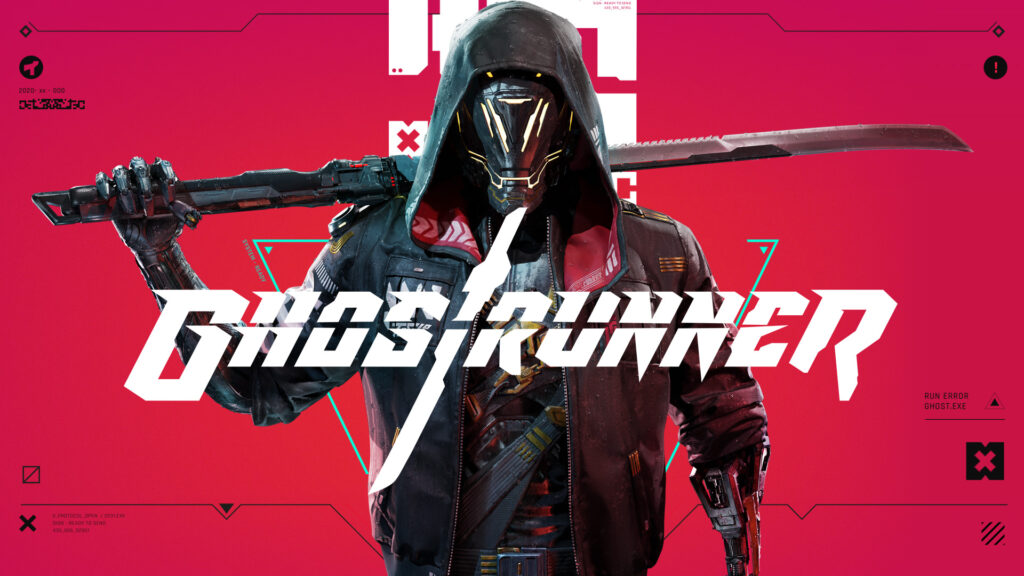
At this point, it’s almost cliché to make a cyberpunk-themed game. The genre is rapidly becoming crowded with clones and stylized games such as Observer (review here) and Dex (review here), as well as older classics like Deus Ex, Shadowrun, and even Beneath A Steel Sky. The genre has been around for a while, but the forthcoming release of Cyberpunk 2077 has created something of a renaissance for cyberpunk and everything seems to have incorporated it, even cooking games such as Neon Noodles.
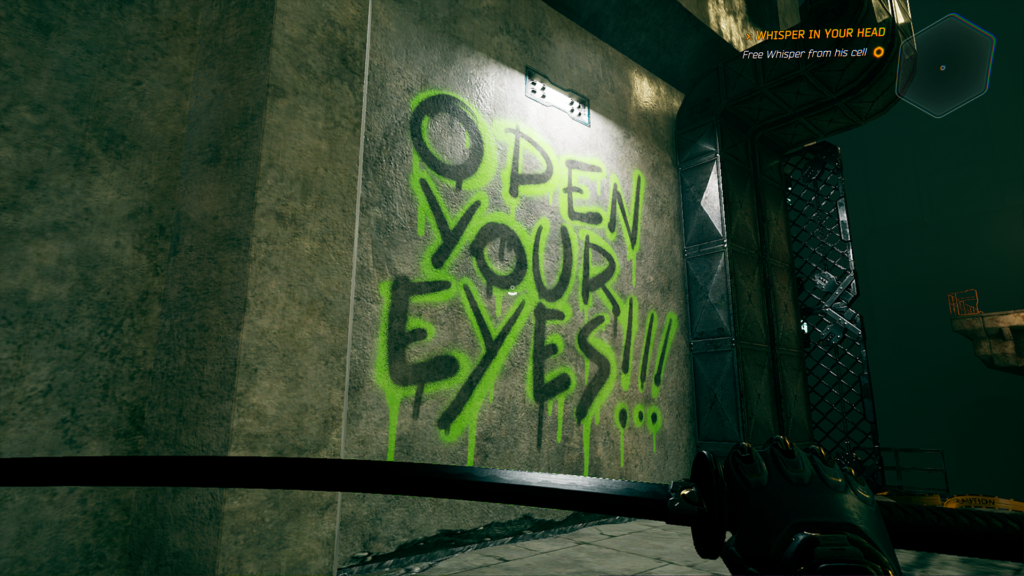
Ghostrunner is yet another cyberpunk game, this time from One More Level and 505 Games. However, it’s also something a bit new and fresh. Part puzzle game, part first person cybernetic ninja FPS, you play a Ghostrunner, an advanced combat cyborg of some sort. Your goal is to scale a tower and destroy the Keymaster who left you for dead. Along the way, you’ll slowly rebuild your body and relearn your skills. The plot isn’t the greatest here, but then again, the focus isn’t exactly heavy on the story sequences. The key here is combat.
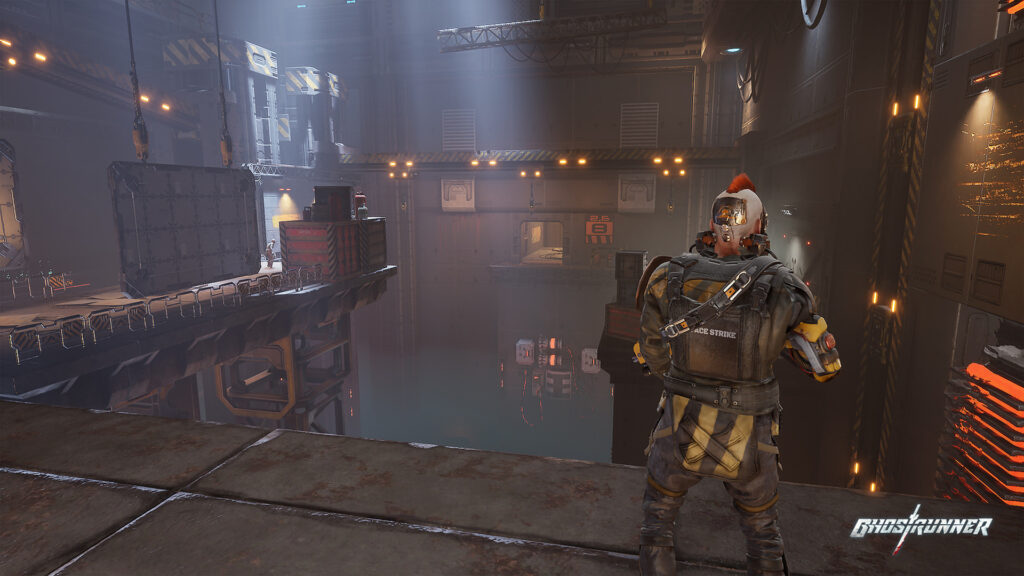
There are very few games out there faster than Ghostrunner. The game moves at an absolutely blistering speed during combat, requiring you to literally slow your perceptions and dodge individual bullets, all while hurtling towards enemies over vast gaps and drops off the sides of buildings, pipes, and scaffolding. One misstep and you’re dead. Hit the wrong button. Dead. Blink. Dead. You die a lot in Ghostrunner. Completing the first level netted me 145 deaths (leave me alone, I’m old and my reflexes aren’t as fast as they used to be). The numbers didn’t drop too much after there. There’s almost no possible way to complete a combat level in Ghost Runner in a single try and let’s not even get started on the bloody bosses.
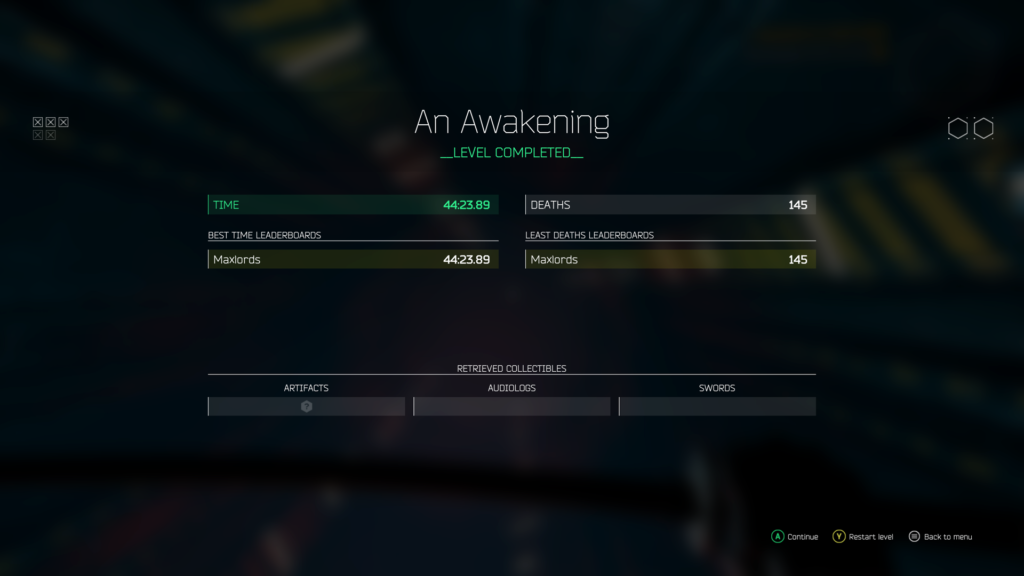
There’s an intriguing design structure here. In many ways, Ghostrunner is simply a puzzle game. But instead of Puyos or Tetrominos, you’re twisting your approach into a level around until you can kill every living thing in a combat segment. Do you go left or right? Up or down? Over a barricade or run along a wall. The idea is to experiment with your approach into a level to maximize your speed and surprise to enemies so you can gut them one after another like a stack of squishy dominoes. It’s both fun and frustrating at the same time, leaving you crowing triumphantly with an eventual success (you’ll get there) or raging impotently at defeat as you instantly reload from your last save point. You’ll definitely be respawning more than you gloat here.
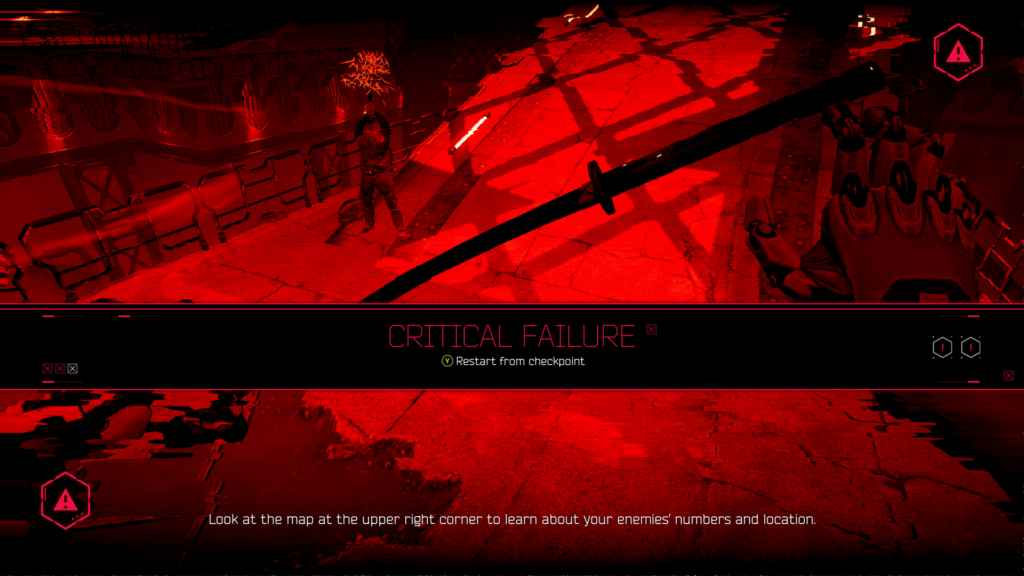
As you progress in the game you’ll gain more and more abilities. At first you can dash and slow time, but along the way you get slide mechanics, electric grappling hooks, multi-attacks, and even the ability to hack the brains of enemies, turning them into temporary allies. You’ll need those extra abilities too as more and more difficult enemies show up the further you climb, leaving you struggling through waves of drones, laser-wielding robots, and enemy ghostrunners. As you progress, you’ll learn new abilities and then immediately be forced to use them to solve the various environmental puzzles and proceed through the game. Hope you’re not afraid of heights! The game leaves you wall-running more often than not, forcing you higher and higher over nauseating drops to reach your goals. Follow the cues and you can run halfway up a level in one go. Turn slightly to the wrong angle and you’ll end up retrying another 20 times. Pretty much the meat of the game is simply refining your path choices and button presses to clear an area then moving to the next. Respawns are essentially instant, allowing you to just fling yourself over and over until you eventually manage to complete a level. This is more of a patience thing than a skill thing, and while it does seem like a lot of gamers love the game, from a design standpoint it’s a bit weird.

On top of the combat and environmental puzzles, there are several bosses throughout your tower climb, all with varied strategies required and naturally, a metric ton more deaths. Hel is probably the toughest fight because, well, a non-stop katana fight in a one hit one kill game doesn’t last long while you’re trying to learn your opponent’s patterns, not to mention the ridiculous number of environmental hazards and death-defying jumps in the midst of the battle. If you’re anything like me, you’ll fail a lot. And fall a lot. And die trying (yes, that’s a paraphrase from the first Raimi Spider-Man movie).

This is not a game for the impatient. You’ll spend a fair amount of time just retrying each section, and it can get frustrating. But at the same time, it’s a fast game as well, and with a moderate degree of skill and some angry couch punching, you can probably blow through the entire game in around a day or so. It’s not a long game. There are some weird pacing issues too, especially with the levels that take place in cyberspace and you simply jump around from place to place, listening to the narrative and not fighting everyone. In fact, if there’s a word that you can sum Ghostrunner up with, it would probably be uneven. One level is frantic and vicious, the next tedious and slow, the one after, devoid of enemies, and so on. While you’re never doing the same thing for long and the level structure and designs don’t really repeat, you’re also not keeping a constant fervor going, both in the sense that the levels aren’t all high-octane and the fact that if you can’t get the hang of one, you’ll be stuck there for a while.
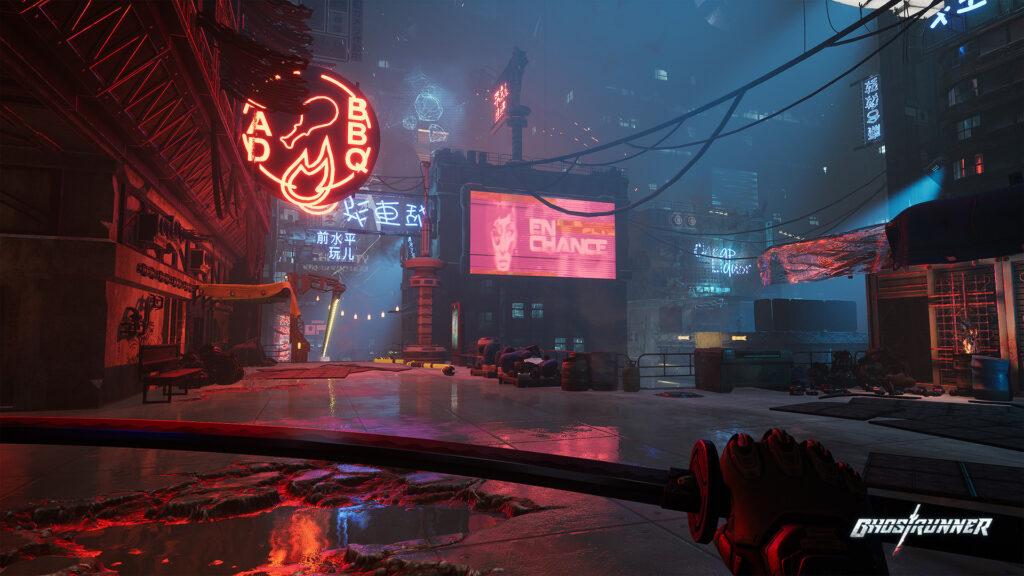
It’s obvious after only a short amount of playtime that Ghostrunner was designed for a mouse and keyboard rather than a controller. There’s a disconnect between the controller’s response time and camera movement that can’t really be easily quantified in a few sentences. It’s hard to explain, but if you’re both a PC and console gamer, some games, especially first person games, feel different somehow when played on a console. Perhaps it’s the way mouselook functions, or the number of independent buttons you can hit with your left hand while controlling the game with your mouse. Regardless, using a controller for Ghostrunner feels fundamentally wrong. Not bad, just wrong. Controls are tight and responsive, and I’ve never used the shoulder buttons on the Xbox controller as much as I have with this game, but it’s obvious that you could eke more performance out of a PC control scheme on this one.
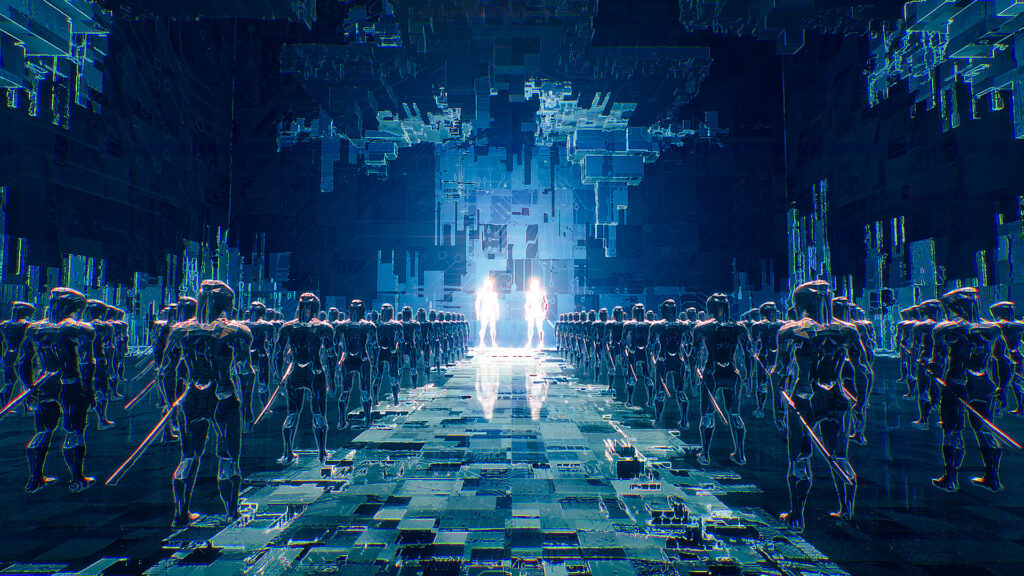
However, Ghostrunner might be difficult and frustrating, but it is also absolutely gorgeous. This game is definitely a contender for how a next-gen title should look. The rusted out neon of a decaying society is outstanding ,the physics are excellent, and the kills are viscera-spattered works of art. If there’s a real complaint to be had about Ghostrunner’s visuals, it’s that the game is so fast and requires so much focus that you can’t actually really enjoy the insane amount of detail that’s been put into every texture, line, and graphic of the game. It’s honestly a shame that there isn’t a slower-paced mode just so you can look around everywhere. There’s a thumping techno soundtrack to go with it as well, of course. However, if you die as incredibly frequently as I did, eventually the music can get more than a bit repetitive, and some levels are much quieter than you’d expect, but all in all it’s a solid soundtrack that meshes quite nicely with the style-soaked vistas of the game.
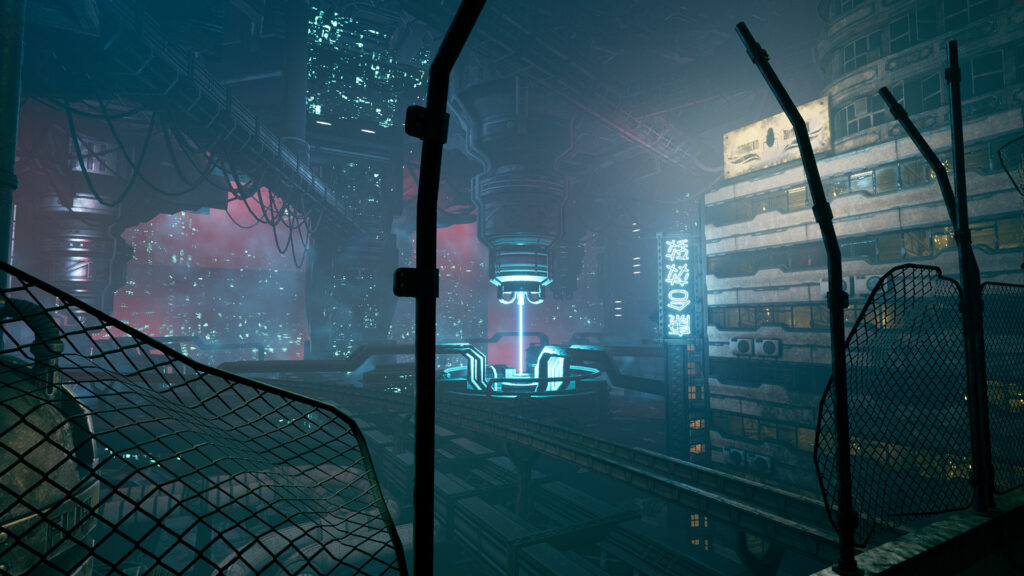
It should be noted that I started this review on the Xbox One X. Normally it’s not something to mention mid-review, but it just so happens that Ghostrunner dropped about the same time as the Xbox Series X and is enhanced for the new system. Naturally, it was worth a look at the comparison. On the Xbox One X, Ghostrunner had a fair bit of load time initially, somewhere between a minute and a minute and a half. Not unexpected with the visuals, but it required a bit of patience. Once the game was loaded, respawns were almost instant but loading levels took a fair amount of time. Once I installed the game on the Xbox Series X, that initial load time dropped to somewhere between 4 and 5 seconds. Yes, seconds. Load times are so fast on the Series X that it’s hard to even process that a system can run that fast. Loading a new level? You’ll be lucky to count to five. It’s honestly a whole new world in terms of system responsiveness. Oh, and did I mention that my save automatically transferred over to the new system and worked perfectly? No? Well, it’s awesome.
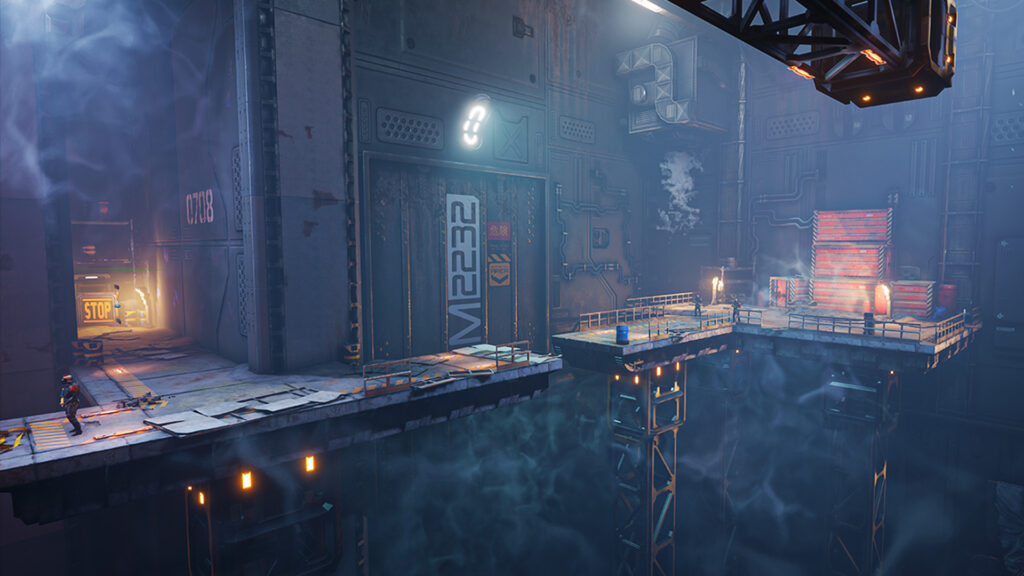
Ghostrunner is an awesome, intensely violent game with a bearable plot, insane visuals, and some unique ways of creating puzzles to solve. It’s not going to be everyone’s cup of tea, but it’s certainly one of the more unique titles that has made its way onto the market in the last couple years and it’s worth taking a closer look at. For the Xbox One X/Xbox Series X, the game is only $30, and honestly, the price is fair considering the gameplay. This is a unique puzzle/FPS/cyberpunk dystopia and one that people will be talking about for some time. Just be prepared to hone your reflexes if you want to reach the top of that tower!
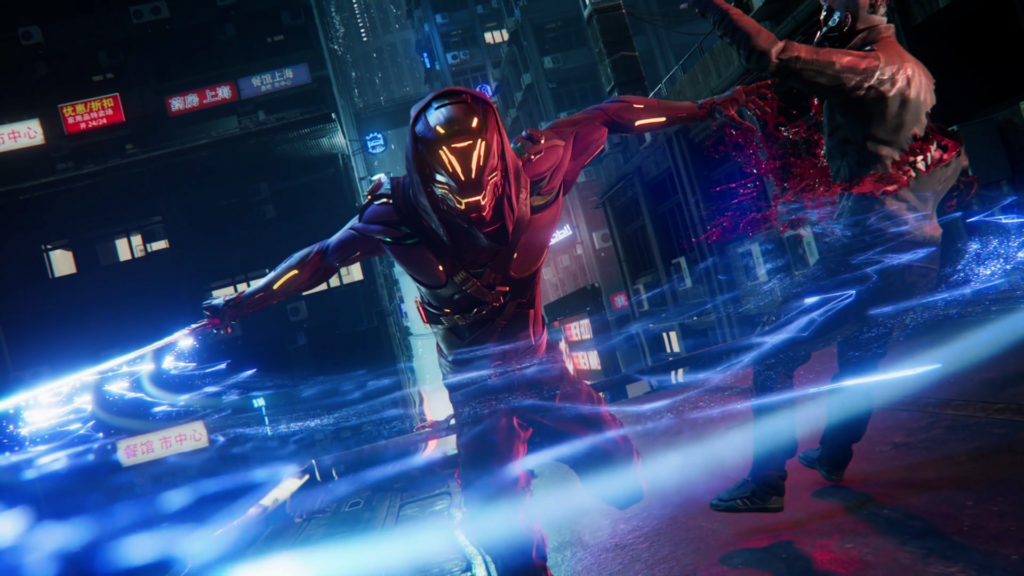
This review was based on a digital copy of Ghostrunner provided by the publisher. It was played on an Xbox One X as well as an Xbox Series X using a 55” 1080P Sony TV. Ghostrunner is also available for Steam, Epic, GOG, PS4, PS5, and Switch. Photos do not do the game justice and some are stock press shots as Ghostrunner is so damned fast that it was near impossible to capture images with the Xbox Series X controller since the capture button only records video and can’t be converted to take photos.

